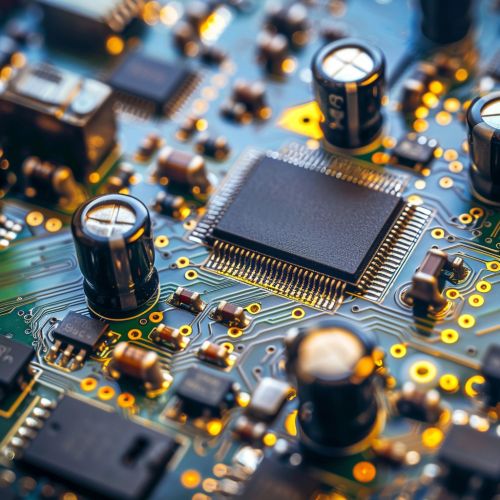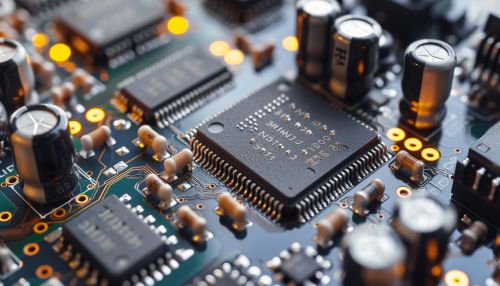Digital logic
Introduction
Digital logic is a foundational concept in the field of computer science and electrical engineering. It involves the use of binary values (0 and 1) to represent and manipulate information. Digital logic forms the basis of digital circuits, which are essential components of computers, communication systems, and many other electronic devices. This article delves into the principles, components, and applications of digital logic, providing a comprehensive understanding of the subject.
Basic Concepts
Digital logic operates on binary numbers, which are represented using two states: 0 and 1. These states can correspond to different physical quantities such as voltage levels, magnetic polarities, or light intensities. The primary building blocks of digital logic are logic gates, which perform basic logical functions.
Binary System
The binary system is a base-2 numeral system that uses two symbols: 0 and 1. Each digit in a binary number is called a bit. Binary numbers are used in digital logic because they are easily represented by the two states of a digital circuit.
Logic Gates
Logic gates are the fundamental components of digital circuits. They perform basic logical operations on one or more binary inputs to produce a single binary output. The most common types of logic gates are:
- **AND Gate**: Outputs 1 only if all inputs are 1.
- **OR Gate**: Outputs 1 if at least one input is 1.
- **NOT Gate**: Outputs the inverse of the input.
- **NAND Gate**: Outputs 0 only if all inputs are 1.
- **NOR Gate**: Outputs 0 if at least one input is 1.
- **XOR Gate**: Outputs 1 if an odd number of inputs are 1.
- **XNOR Gate**: Outputs 1 if an even number of inputs are 1.
Combinational Logic
Combinational logic refers to circuits where the output is a pure function of the current inputs. These circuits do not have memory elements and do not depend on previous inputs.
Boolean Algebra
Boolean algebra is a mathematical framework used to analyze and simplify digital logic circuits. It involves variables that take binary values and operations such as AND, OR, and NOT. Boolean expressions can be simplified using various theorems and laws, such as De Morgan's laws, to optimize digital circuits.
Karnaugh Maps
Karnaugh maps are graphical tools used to simplify Boolean expressions. They provide a visual method of minimizing logical expressions by grouping adjacent cells representing the same output value. This simplification helps in designing more efficient digital circuits.
Multiplexers and Demultiplexers
Multiplexers (MUX) are combinational circuits that select one of several input signals and forward the selected input to a single output line. Demultiplexers (DEMUX) perform the reverse operation, distributing a single input signal to one of several output lines based on control signals.
Sequential Logic
Sequential logic circuits have memory elements and their outputs depend on both current and previous inputs. These circuits are used to design memory devices, counters, and other state-dependent systems.
Flip-Flops
Flip-flops are basic memory elements in sequential logic circuits. They store a single bit of data and have two stable states. The most common types of flip-flops are:
- **SR Flip-Flop**: Set-Reset flip-flop, which has set and reset inputs.
- **D Flip-Flop**: Data flip-flop, which captures the input value on a clock edge.
- **JK Flip-Flop**: A versatile flip-flop with J and K inputs that can toggle its state.
- **T Flip-Flop**: Toggle flip-flop, which changes state on each clock pulse.
Registers
Registers are groups of flip-flops used to store multiple bits of data. They are essential components of digital systems, used for temporary data storage, data transfer, and synchronization.
Counters
Counters are sequential circuits that count pulses and produce a binary count as output. They can be classified as synchronous or asynchronous based on the clocking method. Counters are widely used in digital clocks, timers, and other applications requiring counting.
Finite State Machines
Finite state machines (FSM) are models of computation used to design sequential logic circuits. An FSM consists of a finite number of states, transitions between states, and actions associated with each state. There are two types of FSMs:
- **Moore Machine**: The output depends only on the current state.
- **Mealy Machine**: The output depends on both the current state and the current inputs.
Digital Circuit Design
Designing digital circuits involves several steps, including specification, synthesis, simulation, and verification. The design process aims to create efficient and reliable circuits that meet the desired specifications.
Hardware Description Languages
Hardware description languages (HDLs) such as Verilog and VHDL are used to describe the structure and behavior of digital circuits. HDLs enable designers to model, simulate, and synthesize digital systems at various levels of abstraction.
Field-Programmable Gate Arrays
Field-programmable gate arrays (FPGAs) are integrated circuits that can be configured by the user after manufacturing. FPGAs consist of an array of programmable logic blocks and interconnects, allowing designers to implement custom digital circuits.


Applications of Digital Logic
Digital logic is ubiquitous in modern technology, with applications spanning various fields.
Computers
Digital logic is the backbone of computer systems. Central processing units (CPUs), memory units, and peripheral devices all rely on digital logic circuits to perform their functions.
Communication Systems
Digital logic is crucial in communication systems, including data transmission, error detection and correction, and signal processing. Modems, routers, and other communication devices use digital logic to encode, decode, and process information.
Control Systems
Digital logic is used in control systems to automate processes and manage operations. Programmable logic controllers (PLCs) and microcontrollers are examples of devices that use digital logic to control machinery, industrial processes, and consumer electronics.
Embedded Systems
Embedded systems are specialized computing systems that perform dedicated functions within larger systems. They are found in a wide range of applications, from automotive electronics to medical devices, and rely heavily on digital logic for their operation.
See Also
- Boolean Algebra
- Finite State Machine
- Hardware Description Language
- Field-Programmable Gate Array
- Sequential Logic
